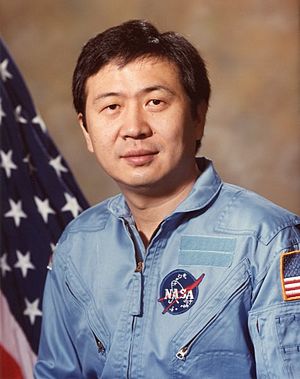Taylor Wang facts for kids
Quick facts for kids
Taylor Gun-Jin Wang
|
|
|---|---|
 |
|
| Born | June 16, 1940 |
| Occupation | Scientist |
| Space career | |
| JPL Payload Specialist | |
|
Time in space
|
7d 00h 08m |
| Missions | STS-51-B |
|
Mission insignia
|
|
Taylor Gun-Jin Wang (born June 16, 1940) is a scientist who was born in China. In 1985, he made history by becoming the first person of Chinese background to travel into space. He worked for the Jet Propulsion Laboratory (JPL) and flew as a special crew member, called a payload specialist, on the Space Shuttle Challenger during its STS-51-B mission.
Contents
Early Life and Education
Taylor Wang's family came from Yancheng, China. He was born in Shanghai. In 1952, his family moved to Taiwan. He finished elementary school in Kaohsiung. Later, he graduated from high school in Taipei, Taiwan. After that, he moved to Hong Kong.
In 1963, Wang began studying physics at the University of California, Los Angeles (UCLA). He earned his first degree, a Bachelor of Science (BS), in 1967. He then received his Master of Science (MS) in 1968. Finally, he completed his Ph.D. in 1972. His Ph.D. research focused on how materials behave at very cold temperatures.
Career and Space Research
After finishing his Ph.D., Dr. Wang joined the California Institute of Technology's Jet Propulsion Laboratory (JPL) in 1972. He worked there as a senior scientist. At JPL, he helped start and develop new ways to process materials without them touching a container. This is called "containerless processing." He led several important experiments for NASA.
In 1975, he became a citizen of the United States. The next year, he published a paper about how spinning liquids behave in zero gravity. This paper caught the attention of NASA. Because of his work, Wang was chosen as a payload specialist on June 1, 1983. He was selected for the Spacelab-3 mission.
Wang performed many experiments on Earth to prepare for his space mission. He used special systems that could float materials using sound waves. He also used drop towers and airplanes that flew in ways that created brief moments of weightlessness. These tests helped him plan the experiments he would do in space. He also invented a special chamber that uses sound to hold and move materials.
His Spaceflight Mission
Wang flew on the Space Shuttle Challenger mission STS-51-B. This mission lasted from April 29 to May 6, 1985. The Challenger launched from Florida and landed in California. It was the first time the Spacelab laboratory was used for a full mission. The seven astronauts on board did many experiments. These included studying how crystals grow and how liquids behave in space. They also looked at gases in the atmosphere and studied cosmic rays.
Wang was the main designer of an experiment called the Drop Dynamics Module. This experiment was designed to understand how liquid drops act in microgravity. When the experiment started, it did not work correctly. Wang felt a lot of pressure because many people, especially the Chinese community, had high hopes for his work. He was very upset when his experiment failed.
Wang talked with the NASA flight controllers. He really wanted a chance to fix his experiment. He was given permission to try and repair it. He successfully fixed the experiment, which was a great achievement. This event showed his determination to complete his scientific work.
After his mission, Wang had traveled over 2.9 million miles. He orbited Earth 110 times and spent more than 168 hours in space. The STS-51B mission was successful. However, later investigations into the Challenger disaster found that the 51-B mission had a similar problem with its O-rings during launch. This showed how close the mission came to a very serious problem.
Research After Spaceflight
After his space mission, Dr. Taylor Wang used what he learned from his experiments in microgravity. He developed a special system to protect transplanted cells. This system helps cells work well without needing strong medicines that can have bad side effects. It uses a multi-layered capsule to protect the cells.
This new system has been tested successfully in large animals. For example, encapsulated dog pancreas cells were put into dogs that had diabetes. No special medicines were used to stop the body from rejecting the cells. The transplanted cells worked well. They kept the dogs' blood sugar levels normal for over 200 days with just one transplant. If more cells were added later, it helped control blood sugar even longer.
Becoming a Professor
Later, Wang became a special professor at Vanderbilt University in Nashville, Tennessee. He has written about 200 articles for science journals. He also holds 28 patents in the U.S. A patent protects his inventions related to sound, how drops and bubbles behave, and how living cells can be protected. His experiments were carried out in space in 1985, 1992, and 1995.
Awards and Family
Wang has received many awards and honors. These include:
- Space Flight Medal from NASA in 1985
- Exceptional Scientific Achievement Medal from NASA in 1987
- Asian Pacific American Achievement Award in 1989
- Llewellyn J. Evans Distinguished Scientific, Engineering and Management Award in 1994
- Educational Award from Vanderbilt University Alumni League in 1996
- Asian American Engineer of the Year Distinguished Science and Technology Award in 2007
In 1990, he spoke at the United Nations' General Assembly for "Only One Earth Day."
Wang is married to Beverly Feng. They have two sons, Kenneth and Eric.
See also
- List of Asian American astronauts
- Ed Lu
- Leroy Chiao
- Yang Liwei


